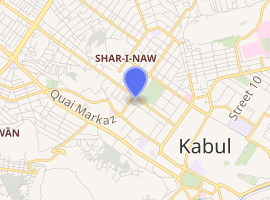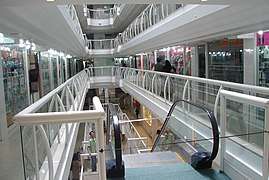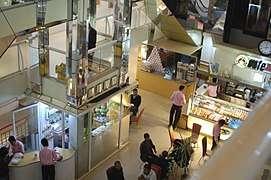Kabul City Center
Kabul City Center (Dari: کابل سیتی سینتر) is a shopping mall located in Shahr-e Naw, Kabul, Afghanistan. Opened in 2005, it consists of 100 stores and food court, as well as equipped with see-through elevators and escalators, which was notable for being the first building in Kabul to be equipped with functional escalators. This building is shared with Safi Landmark Hotel, a 4-star hotel that occupied the top six floor out of total ten stories,[5] which has become one of the famous hotel in Kabul for visitors and foreigners. The building which were famous to foreigners has been subject to terrorism attack which has occurs twice in 2010 and 2011. In 2013, this mall was become notable again for being the mall that houses unofficial Apple Store in Afghanistan which garnered media attention.
| Kabul City Center | |
|---|---|
کابل سیتی سینتر | |
 Kabul City Centre in 2007 | |

| |
| General information | |
| Status | Complete |
| Type | Shopping mall Hotel |
| Architectural style | Postmodern[1] |
| Location | Shahr-e Naw |
| Address | Zargona Road |
| Town or city | Kabul |
| Country | |
| Coordinates | 34.5325°N 69.1656°E |
| Opened | 2005[2] |
| Renovated | 2010[3] |
| Cost | US $ 35 million[4] |
| Owner | Haji Abdul Qudus Safi[5] |
| Technical details | |
| Floor count | 10[4] |
| Lifts/elevators | 3[5] |
| Design and construction | |
| Engineer | Louis Berger Group[6] |
| Other information | |
| Number of stores | 100[4] |
| Number of suites | 40[4] |
| Number of restaurants | 2[4] |
| Website | |
| www | |
History
When Ghulam Hazrat Safi returned to Kabul from Dubai, United Arab Emirates, he invested in US $ 35 million to build both Kabul City Center shopping mall and it's adjacent hotel, Safi Landmark Hotel.[4] Since the opening, the mall employs 150 local staffs and 100 Indian staffs.[5]
On 26 February 2010, the mall was attacked by a Taliban suicide bomber who killed 16 people inside the building, in which 11 are foreigners (9 Indian people, an Italian people, and a French people), 3 Afghani policeman and 2 person of unknown origin. The bombing also causes the windows from this building to shattered and it's debris dropped to pedestrian street nearby, endangering people who are nearby this building. Indian Foreign Affairs described the bombing as intentionally targeting both Indian and Afghani people as death toll are mostly Indian people. However, Zabiullah Mujahid, a spokesman for Taliban, denied the bombing motive is to intentionally targeting Indian people and attempt to erode Afghanistan–India relations, but instead targeting European people as their primary target.[7] The attack of this mall also costs US $ 4 million to bring the mall operation back within two months after the attack.[8]
Immediately after the first bombing, the mall was renovated to install the explosive resistant glass windows[3] and all visitors are screened by metal detectors before being allowed to enter. The screening stopped a suicide bomber from entering the mall on 14 February 2011.[9]
Features
Kabul City Center consists of 100 shops that consists of jewelry store, electronics store, boutique, antique shop and bookstore[10], with food court located on the ground floor which are very similar to most of the European shopping malls. The rental for the shop premise inside the mall in 2007 costs US $ 5050 per month.[11] The main visitor for this mall are mainly foreigners and expatriate.[12] Initially the coffee shop was mostly occupied by man since the opening, however a year later after the opening, more woman starts to appear inside the mall, with food court become the common meeting place between man and woman.[13]
One of the most notable feature of this mall is the escalator which has become one of the most famous attraction in Kabul. This is due to the mall is the first building in Kabul that are equipped with escalator[1] and by far the only building in Afghanistan with working escalator.[6]
The mall has become another media attention when the unofficial Apple Store was opened inside the mall in August 2010.[12] According to an interview with store manager conducted by Quartz in April 2013, he said that their products were sold more expensive than the original price especially iPhone 5 16 GB were sold in Afghanistan for US $ 700, which is $ 50 more than original price sold in United States. These products were imported from Dubai. The sales from this store were healthy, as six iPhone and two MacBook were sold each day, most customers are young people who work at private sector, despite the stocks are limited inside the store. The store manager has considered expansion by adding service and repair center along with open second branch in other Kabul area. While the interviewed store manager did took photo of the store during grand opening and mailed to Apple Inc., Apple Inc. has yet to comment regarding the Afghani store.[14]
 Escalator inside Kabul City Center
Escalator inside Kabul City Center Food court inside Kabul City Center
Food court inside Kabul City Center
Reception
The mall was described as luxury and expensive by most Afghani citizens as most products sold inside this mall are considered unaffordable by most Afghani people,[1] with many people whom commonly known as "gawkers" who asked price and once the price was revealed by salesman, they left the store,[11] and those electronics sold inside this mall are beyond Afghani's imagination where many citizens still lacks access to electricity.[6]
Despite the unaffordability, many Afghani still continues to visit the mall in order to experience the escalator that cannot be found elsewhere in Afghanistan.[1] While some Afghani were surprised with the technology that are not found elsewhere in Afghanistan especially one woman who were surprised when she haven't seen elevator before and had experienced happily for the first time, however, people do not have experience with technology available inside this mall will be having trouble using the facility and had injured one woman who tried to walk on escalator moving in reverse direction.[5]
Some Afghani citizens argued that instead of spending money building the luxurious shops, they should had invest the money in building factories which could create job opportunities for the unemployed in Afghanistan.[5]
References
- Issa, Christine (2006). "Architecture as a Symbol of National Identity in Afghanistan" (PDF). Geographische Rundschau International Edition Vol. 2. Westermann Verlag. Retrieved 23 June 2020.
- "About Kabul". Center of Islamic Banking & Economics. 2010. Retrieved 23 June 2020.
- Partlow, Joshua; Boak, Josh (14 February 2011). "Bomb kills 2 at upscale Kabul hotel complex". Washington Post. Retrieved 23 February 2020.
- W. Herold, Marc (24 April 2006). ""Afghanistan as an Empty Space: thePerfect Neo-Colonial State of the 21st Century" (with 44 photographs)" (PDF). grassrootspeace.org. Traprock Peace Cente. Retrieved 23 June 2020.
- Jawad, Mohammad (20 November 2005). "Afghans Head for the Mall". Institute for War and Peace Reporting. Retrieved 23 June 2020.
- Fariba Nawa. Afghanistan Inc.: A CorpWatch Investigative Report (PDF) (Report). CorpWatch. pp. 2–4. Retrieved 23 June 2020.
- J. Rubin, Alissa (26 February 2010). "Guesthouses Used by Foreigners in Kabul Hit in Deadly Attacks". The New York Times. Retrieved 23 June 2020.
- Shukoor, Hashim; Nissenbaum, Dion (20 October 2010). "Afghan capital enjoys relative calm amid security crackdown". McClatchy DC. Retrieved 23 June 2020.
- Nordland, Rod, and Alissa J. Rubin, "Afghan Guards Called Heroes After Thwarting Attack", New York Times, 14 February 2011.
- Krishnamurthy, Rajeshwari (28 June 2013). "Kabul Diary: Discovering the Indian connection". Gateway House. Retrieved 23 June 2020.
- Holmes, Paul (20 January 2007). "Luxury goods highlight Afghan wealth gap". Reuters. Retrieved 23 June 2020.
- Touryalai, Halah (29 April 2013). "A Fake Apple Store In Afghanistan Is Selling The iPhone 5 For $700". Forbes. Retrieved 23 June 2020.
- Issa, Christine; M. Kohistani, Sardar (July 2007). "Kabul's Urban Identity: An Overview of the Socio-Political Aspects of Development". Penn State University. Retrieved 23 June 2020.
- Mirani, Leo (24 April 2013). "The unofficial Apple store in Afghanistan". Quartz. Retrieved 23 June 2020.
External links
| Wikimedia Commons has media related to Kabul City Center. |
